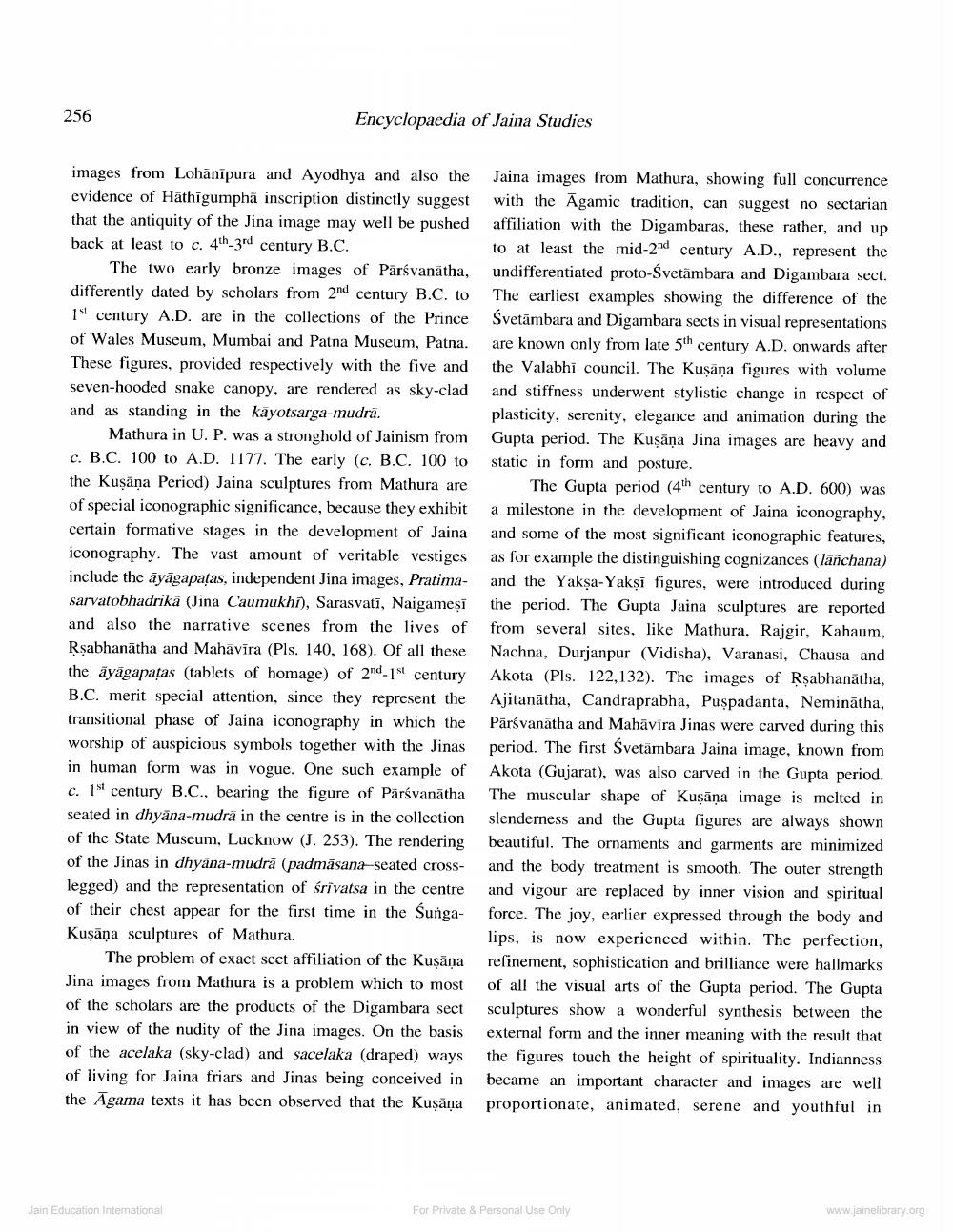________________
256
Encyclopaedia of Jaina Studies
images from Lohānīpura and Ayodhya and also the evidence of Hāthīgumphã inscription distinctly suggest that the antiquity of the Jina image may well be pushed back at least to c. 4th-3rd century B.C.
The two early bronze images of Parsvanātha, differently dated by scholars from 2nd century B.C. to 1st century A.D. are in the collections of the Prince of Wales Museum, Mumbai and Patna Museum, Patna. These figures, provided respectively with the five and seven-hooded snake canopy, are rendered as sky-clad and as standing in the käyotsarga-mudra.
Mathura in U. P. was a stronghold of Jainism from c. B.C. 100 to A.D. 1177. The early (c. B.C. 100 to the Kuşāņa Period) Jaina sculptures from Mathura are of special iconographic significance, because they exhibit certain formative stages in the development of Jaina iconography. The vast amount of veritable vestiges include the āyāgapatas, independent Jina images, Pratimā- sarvatobhadrika (Jina Caumukhi), Sarasvatī, Naigameși and also the narrative scenes from the lives of Rsabhanātha and Mahavīra (Pls. 140, 168). Of all these the āyāgapatas (tablets of homage) of 2nd - 1st century B.C. merit special attention, since they represent the transitional phase of Jaina iconography in which the worship of auspicious symbols together with the Jinas in human form was in vogue. One such example of c. 19 century B.C., bearing the figure of Pārsvanātha seated in dhyana-mudra in the centre is in the collection of the State Museum, Lucknow (J. 253). The rendering of the Jinas in dhyana-mudrā (padmāsana-seated cross- legged) and the representation of srivatsa in the centre of their chest appear for the first time in the Sunga- Kuşāņa sculptures of Mathura.
The problem of exact sect affiliation of the Kuşāņa Jina images from Mathura is a problem which to most of the scholars are the products of the Digambara sect in view of the nudity of the Jina images. On the basis of the acelaka (sky-clad) and sacelaka (draped) ways of living for Jaina friars and Jinas being conceived in the Agama texts it has been observed that the Kuşăņa
Jaina images from Mathura, showing full concurrence with the Agamic tradition, can suggest no sectarian affiliation with the Digambaras, these rather, and up to at least the mid-2nd century A.D., represent the undifferentiated proto-Svetambara and Digambara sect. The earliest examples showing the difference of the Svetāmbara and Digambara sects in visual representations are known only from late 5th century A.D. onwards after the Valabhi council. The Kuşāņa figures with volume and stiffness underwent stylistic change in respect of plasticity, serenity, elegance and animation during the Gupta period. The Kuşāņa Jina images are heavy and static in form and posture.
The Gupta period (4th century to A.D. 600) was a milestone in the development of Jaina iconography, and some of the most significant iconographic features, as for example the distinguishing cognizances (lañchana) and the Yakşa-Yakşi figures, were introduced during the period. The Gupta Jaina sculptures are reported from several sites, like Mathura, Rajgir, Kahaum, Nachna, Durjanpur (Vidisha), Varanasi, Chausa and Akota (Pls. 122,132). The images of Rşabhanātha, Ajitanātha, Candraprabha, Puspadanta, Neminātha, Pärsvanatha and Mahāvīra Jinas were carved during this period. The first Svetāmbara Jaina image, known from Akota (Gujarat), was also carved in the Gupta period. The muscular shape of Kuşāņa image is melted in slenderness and the Gupta figures are always shown beautiful. The ornaments and garments are minimized and the body treatment is smooth. The outer strength and vigour are replaced by inner vision and spiritual force. The joy, earlier expressed through the body and lips, is now experienced within. The perfection, refinement, sophistication and brilliance were hallmarks of all the visual arts of the Gupta period. The Gupta sculptures show a wonderful synthesis between the external form and the inner meaning with the result that the figures touch the height of spirituality. Indianness became an important character and images are well proportionate, animated, serene and youthful in
Jain Education International
For Private & Personal Use Only
www.jainelibrary.org
Jain Education International
For Private & Personal Use Only




